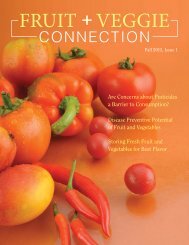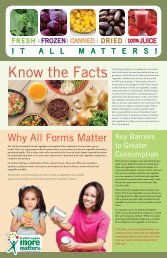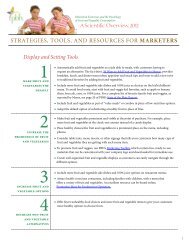The WIC Fruit and Vegetable Cash Voucher - Produce for Better ...
The WIC Fruit and Vegetable Cash Voucher - Produce for Better ...
The WIC Fruit and Vegetable Cash Voucher - Produce for Better ...
You also want an ePaper? Increase the reach of your titles
YUMPU automatically turns print PDFs into web optimized ePapers that Google loves.
markets or about nutritional content of specific fruits <strong>and</strong> vegetables ordifferent <strong>for</strong>ms (canned, frozen, or fresh).For our comparison, we selected the 10 fruits <strong>and</strong> 10 vegetables <strong>for</strong> whichthe highest quantities were purchased by Nielsen households between 2004<strong>and</strong> 2006. We investigated the following vegetables (in order of highest tolowest aggregate quantity purchased by all Nielsen households): tomatoes,onions, lettuce, green beans, corn, carrots, broccoli, cucumbers, peppers,<strong>and</strong> cabbage. We also investigated the following fruits (in order of highestto lowest amount purchased): bananas, apples, watermelons, oranges,grapes, strawberries, peaches, pineapples, pears, <strong>and</strong> grapefruit. <strong>The</strong>se 20items represent approximately 77 percent of all fruit <strong>and</strong> vegetable quantitiespurchased. This list would be similar if we selected the 10 fruits <strong>and</strong>10 vegetables with the highest expenditures rather than the most purchases,except that the vegetable expenditure list would include mushrooms insteadof cabbage, <strong>and</strong> the fruit expenditure list would include cherries instead ofgrapefruit.<strong>The</strong> mean market price <strong>for</strong> each item is calculated in two stages. <strong>The</strong> firststage determines the seasonal price, which is an expenditure-share-weightedaverage price of the <strong>for</strong>m of processing, according to equation 1. <strong>The</strong> secondstage is the average across seasons <strong>and</strong> years:∑∑∑∑∑( )(1)<strong>The</strong> subscripts index the following:• c = purchase• h = household• i = individual fruit or vegetable• f = <strong>for</strong>m• m = market• s = season• y = year._Ρmisy is the mean price in each market (m) <strong>for</strong> each item (i, fruit or vegetable)by season (s) by year (y); E isyfhc is the household (h) expenditure <strong>for</strong> a givenpurchase (c) of a <strong>for</strong>m of an item (f) in a given season <strong>and</strong> year; L isyfhc is thetotal number of pounds <strong>for</strong> this household purchase of a <strong>for</strong>m of an item in agiven season <strong>and</strong> year; <strong>and</strong> W his the household aggregation weight (projectionfactor) developed by Nielsen.<strong>The</strong> first fraction in equation 1 is the market-level mean price per pound <strong>for</strong>each <strong>for</strong>m of processing of each fruit <strong>and</strong> vegetable by season <strong>and</strong> year. <strong>The</strong>price each household paid <strong>for</strong> each <strong>for</strong>m of processing of each fruit <strong>and</strong> vegetableis calculated by dividing the sum of all expenditures on each purchaseby the sum of all pounds in each purchase in each season of each year. To6<strong>The</strong> <strong>WIC</strong> <strong>Fruit</strong> <strong>and</strong> <strong>Vegetable</strong> <strong>Cash</strong> <strong>Voucher</strong>: Does Regional Price Variation Affect Buying Power? / EIB-75Economic Research Service/USDA











